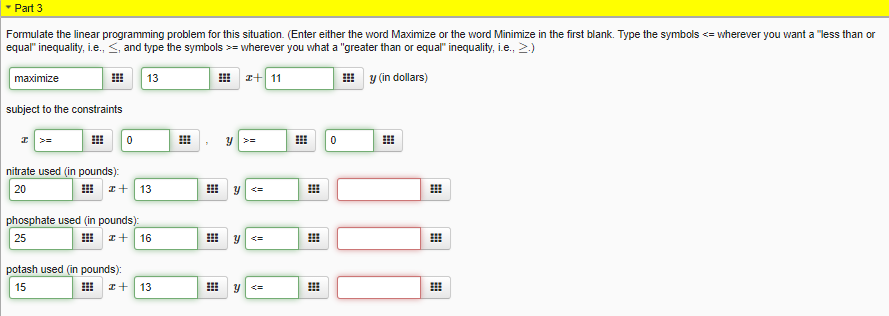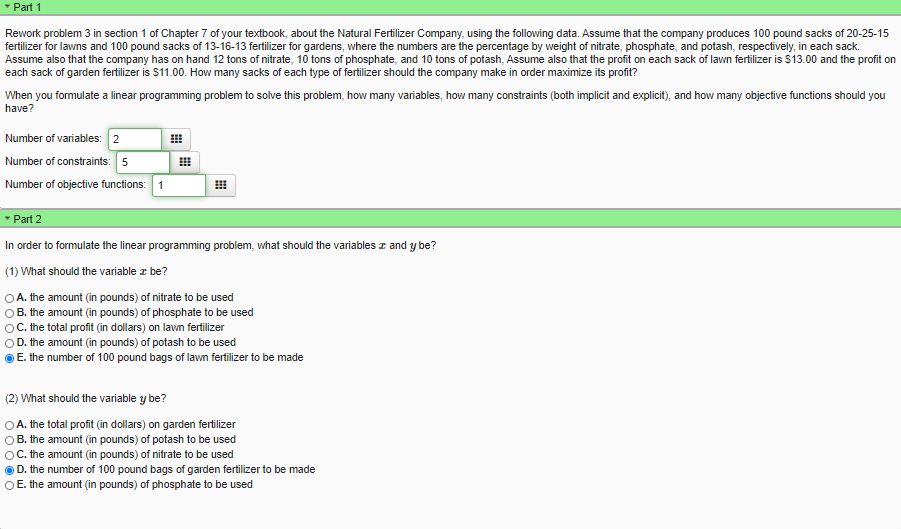Part 3 Formulate the linear programming problem for this situation. (Enter either the word Maximize or the word Minimize in the first blank. Type the symbols <= wherever you want a "less than or equal" inequality, i.e.,s and type the symbols >= wherever you what a "greater than or equal" inequality, i.e., 2) maximize | 13 I z+ 11 I y (in dollars) subject to the constraints nitrate used (in pounds): 出エ+| 13 20 phosphate used (in pounds): 25 田エ+| 16 potash used (in pounds): 15 z+ 13
Part 3 Formulate the linear programming problem for this situation. (Enter either the word Maximize or the word Minimize in the first blank. Type the symbols <= wherever you want a "less than or equal" inequality, i.e.,s and type the symbols >= wherever you what a "greater than or equal" inequality, i.e., 2) maximize | 13 I z+ 11 I y (in dollars) subject to the constraints nitrate used (in pounds): 出エ+| 13 20 phosphate used (in pounds): 25 田エ+| 16 potash used (in pounds): 15 z+ 13
Functions and Change: A Modeling Approach to College Algebra (MindTap Course List)
6th Edition
ISBN:9781337111348
Author:Bruce Crauder, Benny Evans, Alan Noell
Publisher:Bruce Crauder, Benny Evans, Alan Noell
Chapter5: A Survey Of Other Common Functions
Section5.3: Modeling Data With Power Functions
Problem 6E: Urban Travel Times Population of cities and driving times are related, as shown in the accompanying...
Related questions
Question
need help with part 3

Transcribed Image Text:* Part 3
Formulate the linear programming problem for this situation. (Enter either the word Maximize or the word Minimize in the first blank. Type the symbols <= wherever you want a "less than or
equal" inequality, i.e., <, and type the symbols >= wherever you what a "greater than or equal" inequality, i.e., >.)
出 エ+| 11
H y (in dollars)
maximize
13
subject to the constraints
I >=
nitrate used (in pounds):
20
出 エ+
13
Y <=
phosphate used (in pounds):
25
I z+
16
potash used (in pounds):
15
I+| 13
Y <=

Transcribed Image Text:* Part 1
Rework problem 3 in section 1 of Chapter 7 of your textbook, about the Natural Fertilizer Company, using the following data. Assume that the company produces 100 pound sacks of 20-25-15
fertilizer for lawns and 100 pound sacks of 13-16-13 fertilizer for gardens, where the numbers are the percentage by weight of nitrate, phosphate, and potash, respectively, in each sack.
Assume also that the company has on hand 12 tons of nitrate, 10 tons of phosphate, and 10 tons of potash, Assume also that the profit on each sack of lawn fertilizer is $13.00 and the profit on
each sack of garden fertilizer is $11.00. How many sacks of each type of fertilizer should the company make in order maximize its profit?
When you formulate a linear programming problem to solve this problem, how many variables, how many constraints (both implicit and explicit), and how many objective functions should you
have?
Number of variables: 2
Number of constraints: 5
Number of objective functions: 1
- Part 2
In order to formulate the linear programming problem, what should the variables z and y be?
(1) What should the variable z be?
OA. the amount (in pounds) of nitrate to be used
OB. the amount (in pounds) of phosphate to be used
Oc the total profit (in dollars) on lawn fertilizer
OD. the amount (in pounds) of potash to be used
E. the number of 100 pound bags of lawn fertilizer to be made
(2) What should the variable y be?
OA. the total profit (in dollars) on garden fertilizer
OB. the amount (in pounds) of potash to be used
OC. the amount (in pounds) of nitrate to be used
D. the number of 100 pound bags of garden fertilizer to be made
OE. the amount (in pounds) of phosphate to be used
Expert Solution
This question has been solved!
Explore an expertly crafted, step-by-step solution for a thorough understanding of key concepts.
This is a popular solution!
Trending now
This is a popular solution!
Step by step
Solved in 2 steps

Knowledge Booster
Learn more about
Need a deep-dive on the concept behind this application? Look no further. Learn more about this topic, statistics and related others by exploring similar questions and additional content below.Recommended textbooks for you

Functions and Change: A Modeling Approach to Coll…
Algebra
ISBN:
9781337111348
Author:
Bruce Crauder, Benny Evans, Alan Noell
Publisher:
Cengage Learning

Functions and Change: A Modeling Approach to Coll…
Algebra
ISBN:
9781337111348
Author:
Bruce Crauder, Benny Evans, Alan Noell
Publisher:
Cengage Learning